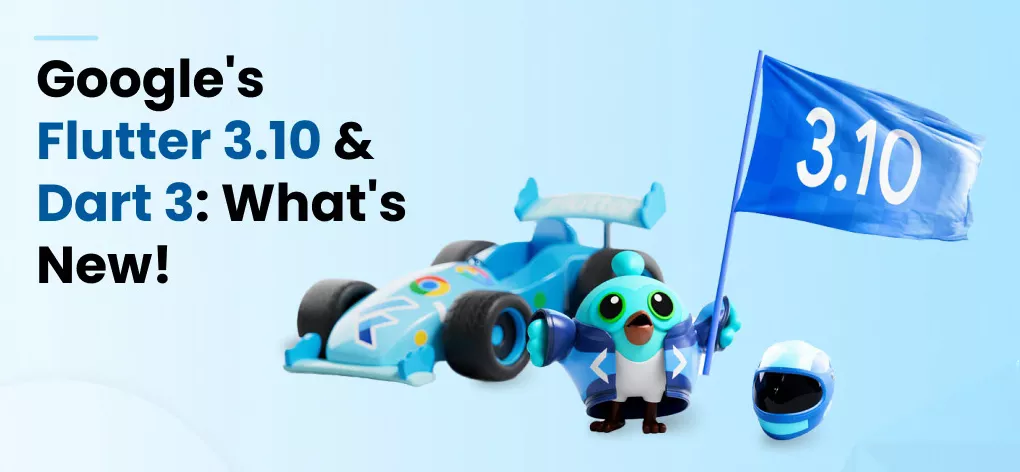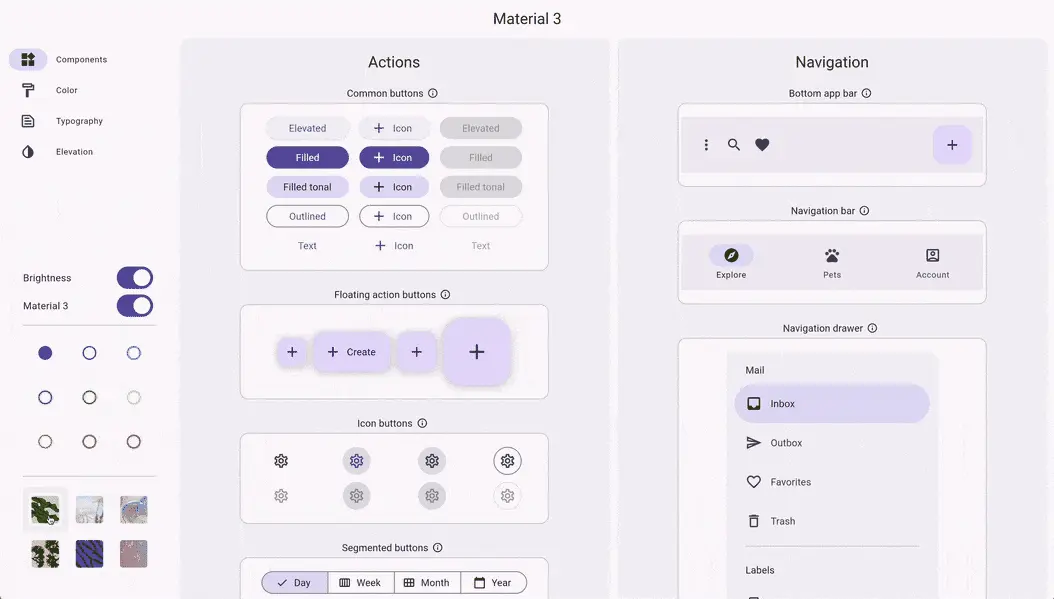


Google has launched Dart 3, a major update to the programming language, and the accompanying Flutter 3.10 UI toolkit for mobile, web, and desktop applications, with design and macOS/iOS enhancements. In addition to sound null safety and new language features, Dart 3 previews WebAssembly (Wasm) compilation.
Flutter is a dynamic framework known for its unwavering commitment to improvement and thrives within its strong and vibrant community. With an ever-evolving set of features, bug fixes, and performance enhancements, Flutter always ensures developers have the latest tools at their disposal.
And its latest improvement in the Flutter 3.10 version just proves that.
Flexion Infotech presents a quick guide to the latest updates in Flutter 3.10, to empower developers and fuel their innovative journeys.
So, get ready to know about the impressive Flutter 3.10 updates and features to stay ahead with curated insights into the realm of limitless possibilities.
Flutter has just released its new version Flutter 3.10 which includes many improvements for web and mobile application development. It has brought new widgets, security, framework advancements, updates to existing widgets, performance improvements, and much more.
One of the most significant Flutter updates is the improved Material Design Widgets that come with Material 3 and Navigation updates. Additionally, we will also see the introduction of Impeller for better graphics processing and stability improvements and updated Pickers and Bottom Sheet Widgets that have been improved for better functionality. There are also enhancements for web and mobile apps, APIs, and more.
Let us now learn about all the newest improvements and features of Flutter 3.10:
With Dart 3, Flutter 3.10 adds a fantastic new feature to its most well-liked programming language. The significant advancement in Dart 3 is eliminating non-null-safe code, which ensures a 100% error-free and secure experience in this language and eliminates the usual dangers of nullable languages.
In addition, Dart 3 makes several language enhancements, including adding Patterns. This functionality makes working with structured data straightforward.
(String, int) userInfo(Map
{
return (json[‘name’] as String, json[‘height’] as int);
}
As a result, neither a special class nor the collection-based encapsulation of multiple
values will be required.
Additionally, updated switch statements allow for the systematic destruction of
structured patterns, while new class
modifiers like interface class and sealed class give expanded capabilities.
When dealing with open-source code, security is crucial. Because of this, the Flutter team considered it while releasing Flutter 3.10. Level 1 of the Supply Chain Levels for Software Artifacts (SLSA) is currently supported by Flutter 3.10. This approach makes it possible for build scripts to function and run on reputable platforms. It also includes a variety of security measures, such as:
Automated builds on dependable build platforms are now possible with Flutter build scripts. Since artifact tampering is forbidden, building on protected architecture promotes supply chain security.
Workflows for Flutter releases only go live with the permission of many engineers. Each operation generates auditable log files. These adjustments guarantee that the source code and the artifacts produced simultaneously cannot be altered.
This shows that reputable sources made the framework release artifacts with anticipated content. Links are provided to view and confirm provenance on each version’s SDK archive.
With this effort, the team can also get closer to SLSA L2 and L3 compliance. These two levels are dedicated to protecting antiquities both during and after construction. These actions have been implemented in response to recent security issues and security holes discovered in other open-source projects, such as the NPM ecosystem. The Flutter team is actively strengthening the ecosystem’s security to make it more trustworthy and robust for developers and end users.
The speed at which Flutter for the web loads applications has significantly increased. The largest Flutter for the Web component, CanvasKit, has shrunk dramatically in size and is currently one-third of its previous size, a notable feat.
Additionally, you may do away with unnecessary typefaces to lighten the overall weight. With Flutter 3.10, full support for quickly integrating pure HTML components into the application is now available. Furthermore, fragment shader capability is added, allowing developers to create stunning visual effects. This calls for allowing languages with trash collection, such as Flutter, to be incorporated into the standard.

In this Flutter 3.10 release, the development tools have also received several upgrades. New features have also been added to the memory page. The addition of the Diff tool makes it possible to compare memory utilization before and after particular interactions to assess such interactions’ consequences.
Additionally, improvements have eased heap exploration through the console. The DevTools user interface has been enhanced by adding Material 3 widgets, improving usability, and following current design standards. Also, the open-source program Perfetto has taken the role of the antiquated trace viewer. It has, thus, modified the management of large datasets and added features to pin threads of interest, drag and select multiple timeline events, and use SQL queries to retrieve specific timeline data.
With the release of Flutter 3.10, Impeller has taken the position of Skia. It has taken over as iOS’s main rendering engine. This new rendering engine fixes the problematic shader compilation difficulties that led to janky animations and a bad visual experience, which improves animation performance.
To avoid the necessity of shared compilation during graphics rendering, however, Impeller uses a tessellation method. With Flutter 3.10, Impeller is the default rendering engine in all iOS applications. The Flutter team has also emphasized their ongoing efforts in this respect and has stated that a preview version of Impeller for Android will be launched.
The new version introduces Dart 3, a major release of the programming language powering Flutter. This update brings significant enhancements by eliminating non-null-safe code, ensuring a protected and seamless experience in this fully safe language, free from the usual pitfalls of nullable languages.
Dart 3 also introduces language improvements, including the introduction of Patterns. This feature simplifies working with structured data, allowing functions to conveniently return multiple values simultaneously, eliminating the need for collections or dedicated classes.
Furthermore, the updated switch statement enables orderly deconstruction of structured patterns, while new class modifiers like interface class and sealed class offer expanded capabilities.
Google's Flutter 3.10 update revolutionizes the app development landscape, unlocking a realm of possibilities for developers.
It brings a delightful fusion of enhanced features, turbocharged performance, and refreshed widgets, empowering developers to craft visually captivating, lightning-fast, and rock-solid apps. Whether it's the alluring Material Design Widgets or the seamless Navigation updates, Flutter 3.10 simplifies the journey of building top-notch apps.
Embracing stability improvements and leveraging the graphics prowess of Impeller, developers can create apps that boast unprecedented reliability and blazing speed. With updated Pickers and Bottom Sheet Widgets in their arsenal, developers wield even more creative ammunition to fashion immersive user experiences.
Start getting the benefits of Flutter 3.10's groundbreaking updates and elevate your app development prowess with our comprehensive guide.
Well, if you are building a mobile application with Flutter Try using Flexion Infotech Flutter Builder to bring your app faster to the market!
Dart is a programming language and Flutter is an open-source UI (User Interface) toolkit developed by Google. It is the primary language used for building applications with Flutter. Dart is an object-oriented language with a strong type system and supports features such as just-in-time (JIT) compilation for development and ahead-of-time (AOT) compilation for production, allowing for fast execution and efficient performance.
Flutter 3.10 brings improvements such as new widgets, security enhancements, framework advancements, updates to existing widgets, performance improvements, and more.
Dart 3 is a major update to the Dart programming language, which powers Flutter 3.10. It introduces significant language enhancements and eliminates non-null-safe code, ensuring a secure and error-free experience.
Flutter 3.10 supports Level 1 of the Supply Chain Levels for Software Artifacts (SLSA), which includes scripted build processes, multi-party permission with audit logging, and provenance. These measures enhance security and ensure the integrity of the source code and artifacts.
DevTools in Flutter 3.10 received upgrades, including the addition of the Diff tool for comparing memory utilization, improvements to heap exploration, enhanced user interface with Material 3 widgets, and the adoption of the Perfetto trace viewer.